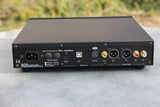With the goal of creating a very affordable, yet superior DAC in mind the designers of Metrum Acoustics have developed a new DAC, the ONYX By Metrum Acoustics.
It was an unprecedented challenge, which was eventually solved by using an entirely new chip, which has been exclusively developed by Metrum Acoustics and was first used in the PAVANE.
The parallel driven R2R ladder networks as used in the four DAC modules performs , especially when combined with our FPGA-driven “forward correction module”, on a higher level. This module splits up the audio samples for each channel into new separate data streams. Each dac cluster processes a portion of the data in the most linear region of the dac chips. The result of this process is an extremely high linearity, right down to -140 dB, which gives the ONYX a realistic 24 bit dynamic range. Due to the dual mono design over the entire frequency range an extremely high channel separation of 120 dB is realized. This contributes to the flawless positioning of instruments.
SPECIFICATIONS
In short, the ONYX is a DAC that has taken all the lessons and experiences that her designer has learned over the years, and combined them in an ambitious DAC that can fit in every system. It is musical, honors the Non-oversampling principle while simultaneously incorporating the technological progress that has been made over the years.








